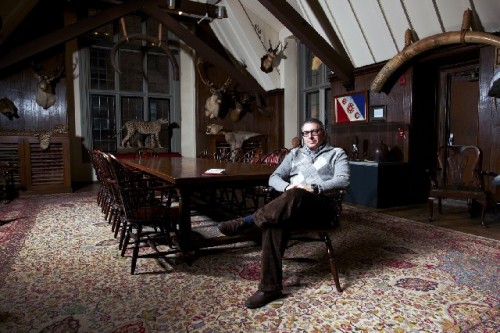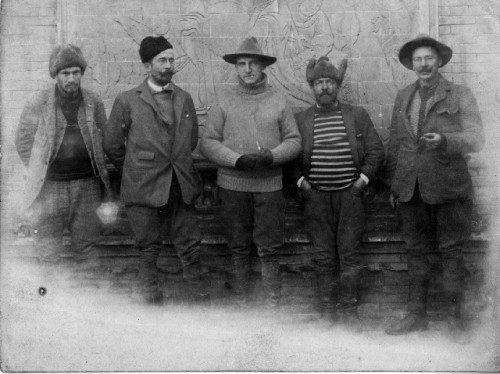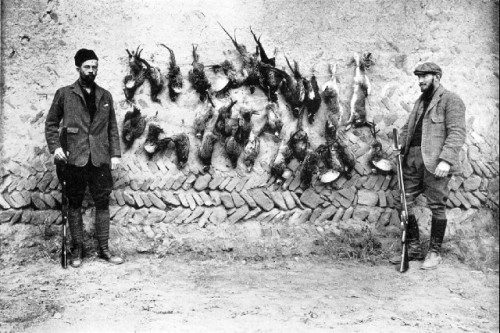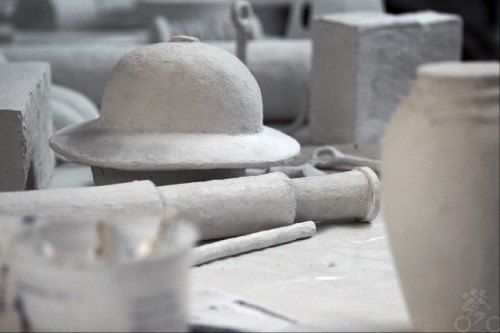Mark Dion's Phantoms of the Clark Expedition
NY's Explorer'c Club Exhibition with Clark Art Institute
By: Clark - May 01, 2012
The Sterling and Francine Clark Art Institute presents a new installation by artist Mark Dion, Phantoms of the Clark Expedition, reflecting on the history of exploration and on an expedition to North China that the Institute’s founder Sterling Clark undertook in 1908. On view May 9 to August 3, 2012, the installation consists of a series of dioramas and sculptures representing objects and specimens that would have been used or collected during expeditions that occurred in that era. The installation is being presented at The Explorers Club at 46 East 70thStreet in New York.
The Clark commissioned Dion to create the new work as part of the Institute’s commemoration of the centennial of the 1912 publication of Through Shên-kan: The Account of the Clark Expedition in North China, 1908–9, written by Sterling Clark and naturalist Arthur de Carle Sowerby. The Explorers Club site was selected both for its connections to the history of exploration and for its links to the Clark family’s history. The Tudor-style building was the former home of Sterling Clark’s brother Stephen, and is the current site of the Clark’s New York office.
“This is an exciting and provocative project by one of the most important contemporary artists working today, with compelling connections to our institution and its history,” said Michael Conforti, director of the Clark. “We are delighted to have this special opportunity to present this new Dion installation in Manhattan and hope that our New York audiences will be inspired to visit our campus in Williamstown this summer to engage with a series of exhibitions tied to modern Chinese archaeology and to Sterling Clark’s pioneering expedition.”
The Dion installation is part of the ClarkNOW initiative announced late last year – a program of some 60 exhibitions, events, and activities taking place in New York, at the Clark in Williamstown, and at international venues as it extends its reach and engagement during the final construction phase of its campus enhancement program.
Curated by Lisa G. Corrin, Director of Northwestern University’s Mary and Leigh Block Museum of Art and a former Clark Fellow, the Dion project features reinterpretations of dozens of objects similar to those typically used on expeditions or found in museums of natural history. After studying records and artifacts from Clark’s China expedition, Dion used his signature red and blue pencils to reinterpret the items in a series of drawings that became the basis of his installation. The drawings have been translated into unpainted papier-mâché sculptures of equipment and tools and surreal “specimens” which Dion describes as cartoons. From a giant moth pinned to a wall to an oversized squirrel, the artist plays with expectations of scale, causing viewers to think twice about what they are seeing. Dion’s stark white creations, colorless “phantoms” of the originals, are intended, in his words, to evoke “the sunbleached bones of expeditions past.”
Phantoms of the Clark Expedition highlights not only what Clark and his team documented in China, but also “what they brought to the site of inquiry,” according to Dion. “Thus the equipment and provisions necessary for undertaking such a complex tour are given a new importance which emphasizes the labor of the journey rather than the particular scientific results. In this way, the Clark team itself becomes the locus of an ethnographic investigation, an attempt to understand the cultural underpinnings of a distinct social group based on their physical belongings.”
The installation is presented in The Explorers Club’s iconic Trophy Room, surrounded by artifacts and specimens collected by the Club’s storied members on historic expeditions to far-flung corners of the globe. Some of Dion’s objects are arranged into tableaux of the expedition archetypes, such as a campfire or provision stores; others are in a more taxonomic grouping based on categories such as utility. Objects in the exhibition represent either the general conditions and needs of all explorers or objects particular to the Clark expedition. An artist-conceived "field guide" will direct visitors through the installation and describe The Explorers Club's history and collection.
“Since the earliest days of exploration art has played an especially important role in chronicling pursuits of discovery,” says Lorie Karnath, past president of The Explorers Club, who led the organization’s decision to team with the Clark on the project. “For much of exploration's history, artists’ renderings provided the sole witness of expedition into the unknown. It is through these that we are able to piece together the landscape, peoples, and species of earlier times. This work by Mark Dion at the headquarters of The Explorers Club intertwines history in a cultural context at many levels. It is fitting that this building, now considered the worldwide center for exploration, provides the setting to contemplate from an artist’s perspective the discoveries of Sterling Clark, this man of adventure.”
Corrin draws parallels between Clark’s pursuits and the example set by one of the leading figures of his day, Theodore Roosevelt. “Like many men of his generation,” she notes, “Clark internalized Theodore Roosevelt’s exhortation that the nation’s future was dependent upon the actions of manly men willing to test their mettle against the unknown, whether it be nature, the frontier, or non-white culture—or all three, as was the case in the Shên-kan expedition.”
Phantoms of the Clark Expedition provides a prelude to two exhibitions and a photographic presentation opening this summer at the Clark’s Williamstown campus. The related shows include Unearthed: Recent Archaeological Discoveries from Northern China (June 16–October 21, 2012), presenting excavated antiquities (fifth through eleventh centuries) from Shanxi and Gansu provinces that have never before been exhibited outside of China; Through Shên-kan: Sterling Clark in China (June 16–September 16, 2012), an exhibition of biological specimens, scientific equipment, historical photographs, and original documents related to Clark’s expedition; and Then & Now: Photographs of Northern China (June 16–September 16, 2012), a presentation of images by contemporary Chinese photographer Li Ju juxtaposed with the historic images from the Clark expedition that they replicate.
The four exhibitions have been organized by the Clark as part of a multi-year initiative connecting Sterling Clark’s pioneering work in China with contemporary audiences. In 2008, the Institute initiated a series of collaborations with Chinese arts agencies and museums to commemorate the 100th anniversary of Clark’s expedition’s centennial. These efforts culminate in the 2012 exhibitions that celebrate the 100th anniversary of the publication of Through Shên-kan. The Clark’s China initiative continues in 2013 when its international tour of masterpieces from its collection of 19th-century French paintings opens at the Shanghai Museum.
Phantoms of the Clark Expedition and its interpretation are supported by the Fernleigh Foundation and David Rodgers.
About the Shên-kan Expedition
The Clark expedition was a massive undertaking involving a large team of scientists and other specialists who traveled through the remote Shanxi, Shaanxi, and Gansu provinces of Northern China on a 17-month trek to collect scientific data and animal specimens, map the area, and create a photographic record of the region’s lands, architecture, and people. Trained as a civil engineer, Clark brought a scientist’s curiosity and method to the planning of his expedition, assembling a talented professional team that included a surveyor, a doctor and meteorologist, an artist, and the famed British naturalist Sowerby, as well as some 30 additional support staff. The expedition was fully outfitted and underwritten by Clark, who had first visited China while serving as an officer in the U.S. Army. Departing from the city of Taiyuan in Shanxi province, the Clark expedition traversed Shên-kan (the provinces of Shaanxi and Gansu), reaching as far westward as Lanzhou before returning to Taiyuan. In all, the team covered nearly 2000 miles (3200 km), primarily on horse and mule. The biological and geological specimens collected on the trek were donated the nascent collections of the young Smithsonian Institution.
About Mark Dion
Mark Dion’s work examines the ways in which dominant ideologies and public institutions shape our understanding of history, knowledge, and the natural world. The job of the artist, he says, is to go against the grain of dominant culture, to challenge perception and convention. Appropriating archaeological and other scientific methods of collecting, ordering, and exhibiting objects, Dion creates works that question the distinctions between “objective” (rational) scientific methods and “subjective” (irrational) influences. The artist’s spectacular and often fantastical curiosity cabinets, modeled on wunderkabinetts of the sixteenth century, exalt atypical orderings of objects and specimens.
By locating the roots of environmental politics and public policy in the construction of knowledge about nature, Dion questions the authoritative role of the scientific voice in contemporary society. He has received numerous awards, including the ninth annual Larry Aldrich Foundation Award (2001) and the Smithsonian American Art Museum’s Lucelia Artist Award (2008). He has had major exhibitions at the Miami Art Museum (2006); The Museum of Modern Art, New York (2004); Aldrich Contemporary Art Museum, Ridgefield, Connecticut (2003); and Tate Gallery, London (1999). “Neukom Vivarium” (2006), a permanent outdoor installation and learning lab for the Olympic Sculpture Park, was commissioned by the Seattle Art Museum. Dion received a BFA (1986) and an honorary doctorate (2003) from the University of Hartford School of Art, Connecticut. He lives and works in New York.
bout The Explorers Club Building
The current home of The Explorers Club was built in 1911, commissioned by Stephen C. Clark, a wealthy businessman, philanthropist, and art collector, as a wedding gift for his new bride. With construction on the house at 46 East 70th Street underway, Stephen Clark turned to his older brother Sterling for advice on many of the details that would ornament the brick townhouse.
The Clark brothers shared a passion for art and architecture, and Sterling played an early and influential role in developing his younger brother’s aesthetic vision. Sterling Clark introduced his brother to many of his art and antique dealers in Europe who assisted Stephen in acquisitions for the New York house, including carved stone mantels and leaded stained glass windows.
The Jacobean-style townhouse is notable for its roofline with two large putti-topped gables, fine ornamental stonework, and an ingenious arrangement of bays of stained glass windows that visually suggest a three-story elevation when, in fact, the house is five-stories high. The treasures Stephen Clark acquired on his sojourns to Europe were installed throughout the house, including elaborate tiles, abundant wood carvings and oak paneling, a grand multi-level staircase, and many exuberantly ornamented plaster-work ceilings to create a luxurious city home. The floor plan combined large public rooms with an arcaded exterior cloister (originally a “hanging garden”) and private family spaces.
Stephen Clark filled his house with his modern art collection, using the large, light-filled room on the fifth floor as a gallery to display many of the best works in his collection, including paintings by Pierre-Auguste Renoir, Paul Cézanne and Vincent van Gogh, including the Dutch artist’s iconic The Night Café. After Stephen Clark’s death in 1960, the house was sold and purchased by The Explorers Club to serve as its new headquarters. Clark’s former art gallery now serves as the club’s Trophy Room, housing a collection that is vastly different, yet equally fascinating.
About the Clark
The Sterling and Francine Clark Art Institute is one of the few major art museums that also serves as a leading international center for research and scholarship. The Clark presents public and education programs and organizes groundbreaking exhibitions that advance new scholarship, and its research and academic programs include an international fellowship program and conferences. The Clark, together with Williams College, America’s foremost liberal arts college, sponsors one of the nation’s leading master’s degree programs in art history.
In 2014, the Clark will open a new Visitor, Exhibition, and Conference Center designed by Pritzker Prize-winning architect Tadao Ando, which is currently under construction on the Clark’s 140-acre campus. The project is part of a phased campus expansion program that includes the renovation of the Clark’s museum building and Manton Research Center.
The Clark is located at 225 South Street in Williamstown, Massachusetts. The galleries are open Tuesday through Sunday, 10:00 am to 5:00 pm (daily in July and August). Admission is free November through May. Admission is $15 June 1 through October 31. Admission is free for children 18 and younger, members, and students with valid ID. For more information, call 413 458 2303 or visit clarkart.edu.
Admission to Phantoms of the Clark Expedition is free. From May 9 – June 30, The Explorers Club is open Monday – Thursday, 11 am – 5 pm; Friday, 11 am – 8 pm; and Saturday, 11 am – 1 pm. From July 1 – August 3, The Explorers Club is open Monday – Thursday, 11 am – 5 pm and Friday, 11 am – 8 pm.





